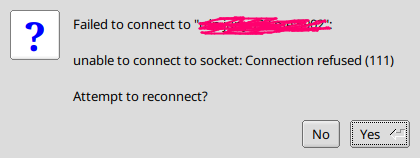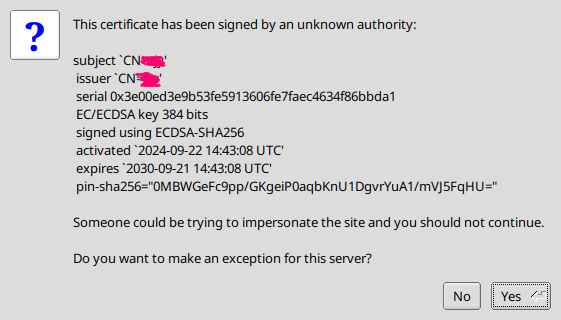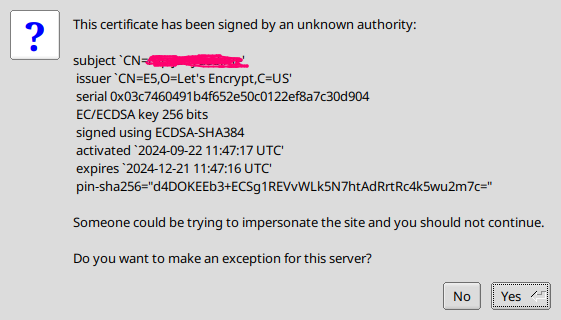从零搭建一个又快又安全的 VNC 服务
因为笔者的寝室电脑有公网 IP,而市面上的远程桌面软件因为使用中继服务器延迟较高,并且个人不信任它们的安全性,所以决定自己搭建一个 VNC 服务。
这样就可以从实验室低延迟的连回寝室电脑,并且保证一定的安全性。
至少让 TigerVNC 觉得 “Connection is secure” without any exemption.
Prerequisites
- 你自己的域名。
- 公网 IP(理论上 IPv4 和 IPv6 均可,本文以 IPv4 为例)。
Steps
申请 DDNS
我的域名是在 Namecheap 买的,但我把自己的 DNS 服务托管给了 Netlify。如果你也是这样,那么你可以使用 Netlify Dynamic DNS 来自动化 DDNS 的流程。当然,如果你是 Cloudflare 的用户,网上的教程应该更多,这里就不赘述了。以下是自己的代码:
#!/bin/bash
# Configuration
ACCESSTOKEN="<access_token>" # Netlify API access token
ZONE="example.com" # Domain name (Netlify DNS zone)
RECORD="subdomain" # Subdomain (subdomain.example.com)
# Get the current public IPv4 (without using proxy)
IP=$(curl --noproxy '*' -s http://ipv4.icanhazip.com)
# Disable IPv6 updates and ensure no proxy for Netlify requests
NDDNS_IPv6_ENABLED=false no_proxy="*.netlify.com" nddns_linux -accesstoken "$ACCESSTOKEN" -zone "$ZONE" -record "$RECORD"
# Log the update
echo "$(date): Updated $RECORD.$ZONE to IP $IP"
然后在 systemd 启用定时任务:
~/Desktop/tmp 10m 8s 22:12:16
> cat /etc/systemd/system/ddns-update.service
[Unit]
Description=Run DDNS update script
[Service]
Type=oneshot
Environment="http_proxy=<http_proxy>" # If you need proxy
Environment="https_proxy=<https_proxy>" # If you need proxy
ExecStart=/bin/bash /home/junyu33/Desktop/tmp/ddns.sh
~/Desktop/tmp 22:12:42
> cat /etc/systemd/system/ddns-update.timer
[Unit]
Description=Run DDNS update script every 30 minutes
[Timer]
OnBootSec=5min
OnUnitActiveSec=30min
Persistent=true
[Install]
WantedBy=timers.target
这样,你的域名就会多一条 TXT 记录,记录着你电脑的公网 IP。
如果你的电脑此时开启了 sshd,你应该可以使用 ssh user@subdomain.example.com 连上自己电脑了。
安装 TigerVNC 服务
参考这篇文章:https://www.digitalocean.com/community/tutorials/how-to-install-and-configure-vnc-on-ubuntu-20-04
看到 Step 2 为止,虽然 Step 3 确实可以达到实际上的安全性,但是 TigerVNC 的客户端会认为连接不安全。
然后这篇文章只提到的 TigerVNC 的服务端安装,客户端在 xubuntu 的安装命令为:
sudo apt install tigervnc-viewer
完成 certbot DNS-01 challenge 以获得证书
xubuntu 的 certbot 包似乎有问题,我选择 conda 虚拟环境下的 certbot pip 包:
pip3 install certbot
certbot certonly --manual --preferred-challenges dns --config-dir ~/Desktop/tmp --work-dir ~/Desktop/tmp --logs-dir ~/Desktop/tmp -d subdomain.example.com
然后按照提示添加 TXT 记录即可。
完成后你会在 ~/Desktop/tmp/archive/subdomain.example.com/ 下看到证书文件。
> /bin/ls -al
total 16
drwxrwxr-x 1 junyu33 junyu33 90 Sep 22 20:45 .
drwx------ 1 junyu33 junyu33 48 Sep 22 20:45 ..
-rw-rw-r-- 1 junyu33 junyu33 1273 Sep 22 20:45 cert1.pem
-rw-rw-r-- 1 junyu33 junyu33 1566 Sep 22 20:45 chain1.pem
-rw-rw-r-- 1 junyu33 junyu33 2839 Sep 22 20:45 fullchain1.pem
-rw------- 1 junyu33 junyu33 241 Sep 22 20:45 privkey1.pem
配置 TigerVNC 安全连接
将你的 certbot 证书复制到 ~/.vnc/ 下:
# 服务器证书和私钥
cp ~/Desktop/tmp/archive/subdomain.example.com/cert1.pem ~/.vnc/subdomain.example.com-SrvCert.pem
cp ~/Desktop/tmp/archive/subdomain.example.com/privkey1.pem ~/.vnc/subdomain.example.com-SrvKey.pem
这里的 pem 文件前缀不一定是
subdomain.example.com,但是之后 TigerVNC启动时,必须要指定正确的 pem 文件。
然后重启 TigerVNC 服务:
vncserver -kill :2
vncserver -SecurityTypes=X509Vnc -X509Cert=/home/junyu33/.vnc/subdomain.example.com-SrvCert.pem \
-X509Key=/home/junyu33/.vnc/subdomain.example.com-SrvKey.pem -localhost=no -geometry=1920x1080 :2
然后将 chain1.pem 复制到客户机的 ~/.vnc/ 下:
# 客户机证书链
scp ~/Desktop/tmp/archive/subdomain.example.com/chain1.pem user@client.com:~/.vnc/chain1.pem
并修改客户机的 ~/.vnc/default.tigervnc,确保这一行的值正确(没有就加一行):
X509CA=/home/junyu33/.vnc/chain1.pem
这个时候启动 TigerVNC,应该会直接看到 “Connection is secure” 的字样并让你输入密码,大功告成。
FAQ
问题零(无法连接):

- 看看你的 DDNS 挂了没。
- 看看你的防火墙关了没。
- 看看你的 TigerVNC 服务启动了没。
问题一(unknown authority,无 Let's Encrypt):

TigerVNC 使用了你系统的自签名证书,而不是 Let's Encrypt 的证书。你可以在启动 log 中找到如下字段:
You will require a certificate to use X509None, X509Vnc, or X509Plain.
I will generate a self signed certificate for you in /home/junyu33/.vnc/<hostname>-SrvCert.pem.
可能是因为你敲重启 TigerVNC 命令的时候没有加 -X509Key 和 -X509Cert 参数。
问题二(域名和证书不匹配):

原因大概跟上一个问题相同,敲重启 TigerVNC 命令的时候没有加 -X509Key 和 -X509Cert 参数。从而使用了你自签的证书,你电脑的 hostname 自然和你连接的服务器不同。
另一种原因是,你 certbot 申请的域名和你的 hostname 不匹配。必须是完全一致的域名,父域名和子域名都要一致。
问题三(unknown authority,有 Let's Encrypt):

你的 .vnc 目录下的 chain1.pem 文件没有复制正确(或者在客户机不存在),或者你的 default.tigervnc 文件没有配置正确。
问题四(TLS初始化错误):

检查一下拷贝证书和私钥的路径是否正确,是不是拷了两个证书或者两个私钥。
问题五(TigerVNC 启动问题):
> vncserver
New Xtigervnc server '<hostname>:3 (junyu33)' on port 5903 for display :3.
Use xtigervncviewer -SecurityTypes VncAuth -passwd /tmp/tigervnc.E2491i/passwd :3 to connect to the VNC server.
=================== tail /home/junyu33/.vnc/<hostname>:3.log ===================
The XKEYBOARD keymap compiler (xkbcomp) reports:
> Warning: Could not resolve keysym XF86CameraAccessEnable
> Warning: Could not resolve keysym XF86CameraAccessDisable
> Warning: Could not resolve keysym XF86CameraAccessToggle
> Warning: Could not resolve keysym XF86NextElement
> Warning: Could not resolve keysym XF86PreviousElement
> Warning: Could not resolve keysym XF86AutopilotEngageToggle
> Warning: Could not resolve keysym XF86MarkWaypoint
> Warning: Could not resolve keysym XF86Sos
> Warning: Could not resolve keysym XF86NavChart
> Warning: Could not resolve keysym XF86FishingChart
> Warning: Could not resolve keysym XF86SingleRangeRadar
> Warning: Could not resolve keysym XF86DualRangeRadar
> Warning: Could not resolve keysym XF86RadarOverlay
> Warning: Could not resolve keysym XF86TraditionalSonar
> Warning: Could not resolve keysym XF86ClearvuSonar
> Warning: Could not resolve keysym XF86SidevuSonar
> Warning: Could not resolve keysym XF86NavInfo
Errors from xkbcomp are not fatal to the X server
X connection to :3 broken (explicit kill or server shutdown).
ComparingUpdateTracker: 0 pixels in / 0 pixels out
ComparingUpdateTracker: (1:-nan ratio)
Killing Xtigervnc process ID 8172... success!
=========================================================================
Session startup via '/etc/X11/Xtigervnc-session' cleanly exited too early (< 3 seconds)!
Maybe try something simple first, e.g.,
tigervncserver -xstartup /usr/bin/xterm
The X session cleanly exited!
The Xtigervnc server cleanly exited!
这个错误比较棘手,我也没找到根本原因。
我的情况是 /usr/bin/xterm 可以正常运行,然后我在 debug 的时候尝试让 TigerVNC 在 :0 上启动(一般是 :1 和 :2),导致 xfce4 界面报错。我没有仔细看错误框,导致系统删除了任务栏的一些图标,而我并不会还原这些图标,干脆用 btrfs 把 /home 回滚了。
神奇的是,回滚 /home 后,这个问题就消失了。
问题六(The authentication mechanism requested cannot be provided by the computer):
这是在手机的 RVNC Viewer 客户端中出现的错误。奇怪的是,如果不使用加密,手机客户端是可以连接的(当然也会报连接不安全的错误)。
但其实,我基本上也不会在手机上使用 VNC,所以这个问题就不管了。